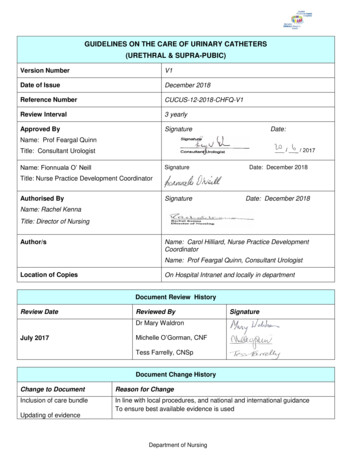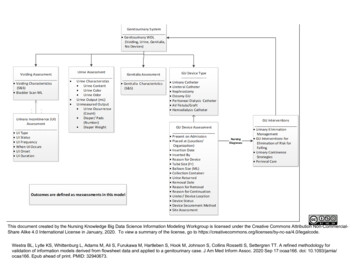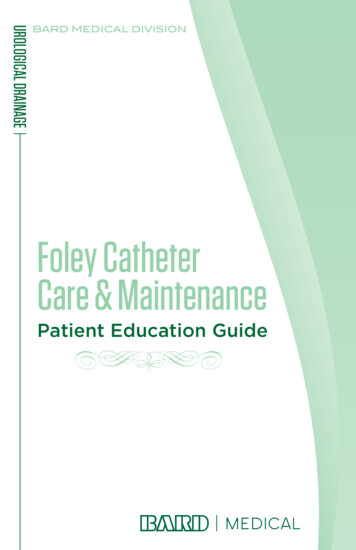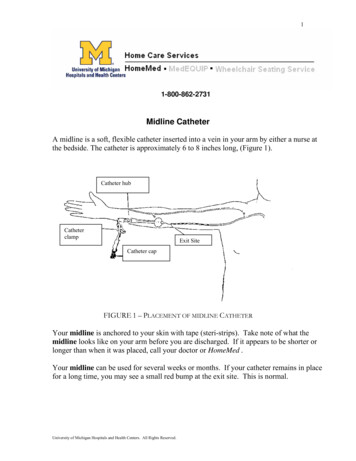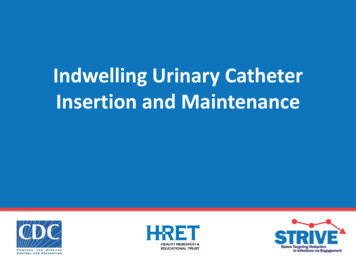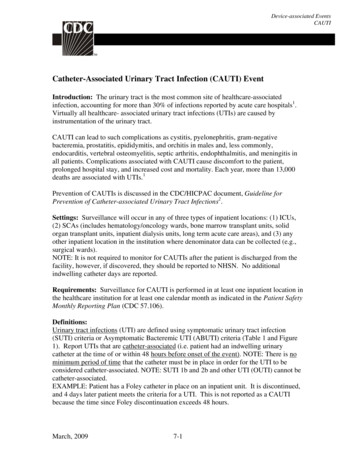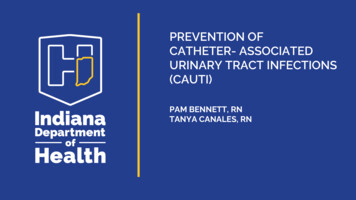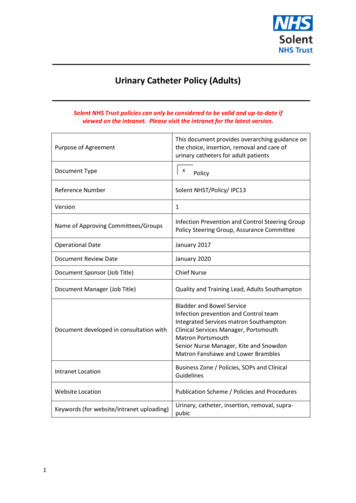
Transcription
Urinary Catheter Policy (Adults)Solent NHS Trust policies can only be considered to be valid and up-to-date ifviewed on the intranet. Please visit the intranet for the latest version.Purpose of AgreementThis document provides overarching guidance onthe choice, insertion, removal and care ofurinary catheters for adult patientsxDocument Type1PolicyReference NumberSolent NHST/Policy/ IPC13Version1Name of Approving Committees/GroupsInfection Prevention and Control Steering GroupPolicy Steering Group, Assurance CommitteeOperational DateJanuary 2017Document Review DateJanuary 2020Document Sponsor (Job Title)Chief NurseDocument Manager (Job Title)Quality and Training Lead, Adults SouthamptonDocument developed in consultation withBladder and Bowel ServiceInfection prevention and Control teamIntegrated Services matron SouthamptonClinical Services Manager, PortsmouthMatron PortsmouthSenior Nurse Manager, Kite and SnowdonMatron Fanshawe and Lower BramblesIntranet LocationBusiness Zone / Policies, SOPs and ClinicalGuidelinesWebsite LocationPublication Scheme / Policies and ProceduresKeywords (for website/intranet uploading)Urinary, catheter, insertion, removal, suprapubic
Amendments Summary:Please fill the table lete re-write fromprevious documentsAction Date2016Review Log:Include details of when the document was last reviewed:VersionReview Date Lead NameRatification ProcessNumber2Notes
SUMMARY OF POLICY 3This document provides overarching guidance on the choice, insertion, removal and care ofurinary catheters for adult patients.It should be used with the associated standard operating procedures on male, female and suprapubic catheterisation, male external continence devices and catheter maintenance solutions.Staff should only provide catheter management if they have been trained and deemedcompetent to do so. Insertion must be via an aseptic non touch technique.A patient should only have a catheter inserted following a risk assessment and according to theirindividual clinical need.All catheters inserted must have the appropriate assessments completed and documents inappendices A and C completed.Antimicrobials should only be commenced following a catheter specimen of urine, change ofcatheter and only if the patient is symptomatic of a urinary tract infection.
Table of ContentsItem ContentsPage1INTRODUCTION AND PURPOSE52SCOPE AND DEFINITION53PROCESS/REQUIREMENTS64ROLES AND RESPONSIBILITIES125TRAINING126EQUALITY IMPACT ASSESSMENT AND MENTAL CAPACITY137SUCCESS CRITERIA / MONITORING EFFECTIVENESS138REVIEW139REFERENCES AND LINKS TO OTHER DOCUMENTS13Appendixes4Appendix A : Adult Indwelling Urinary catheter Insertion/Care Record15Appendix B: Catheter choices17Appendix C: Nurse led catheter removal protocols19Appendix D: Equality Impact Assessment22
Urinary Catheter Policy1.INTRODUCTION & PURPOSE1.1This document provides overarching guidance on the choice, insertion, removal and care ofurinary catheters. Throughout the document, all these elements are included under theumbrella term of catheter management. It should be used in conjunction with theunderlying standard operating procedures.1.2A urinary catheter is an invasive procedure and should not be undertaken without fullconsideration of the benefits and risks. The presence of a catheter can be a traumaticexperience for patients and have huge implications for body image, mobility, pain andcomfort. Indwelling catheters are a key source of urinary tract infections. It is essential thatthey are only used if clinically necessary.2.SCOPE & DEFINITIONS2.1This document applies to all directly and indirectly employed staff within Solent NHS Trustand other persons working within the organisation in line with Solent NHS Trust’s Equality,Diversity and Human Rights Policy document. This document is also recommended toIndependent Contractors as good practice.2.2Solent NHS Trust is committed to the principles of Equality and Diversity and will strive toeliminate unlawful discrimination in all its forms. We will strive towards demonstratingfairness and Equal Opportunities for users of services, carers, the wider community and ourstaff.2.3DEFINITIONS 5Bacteriuria: the presence of bacteria in the urine. In the absence of symptoms, this isreferred to as asymptomatic bacteriuria, or catheter colonisation if the patient has acatheter in situ.Catheter associated urinary tract infection (CAUTI): occurs when pathogens gain accessto the bladder via the outer surface of the catheter causing symptoms such as fever andsupra pubic tenderness. A known risk of having a urinary catheter in situ.Catheter instillation/washout: a solution which is inserted into the bladder via thecatheter. There is mixed evidence of their efficacy.Closed system: aseptic system from catheter tip to drainage bag. However, this is notstrictly accurate as there are numerous portals of entry such as emptying the systemwhen required.Female catheterisation: insertion of a urinary catheter into a femaleIntermittent catheterisation: insertion of a urinary catheter to drain urine or instillsolution into the bladder which is immediately removed and not left in situLong term catheter: a catheter which is in situ for longer than 14 daysMale catheterisation: insertion of a urinary catheter into a maleShort term catheter: a catheter which is left in situ for no longer than 14 daysSupra pubic catheter: a urinary catheter inserted via the anterior abdominal wall directlyinto the bladderUrethral catheterisation: passage of a catheter into the bladder via the urethra
Urinary catheter: a specially designed tube passed into the bladder using aseptictechnique, for the purposes of draining urine, the removal of clots/debris or theinstillation of medication. Throughout this document the term catheter means a urinarycatheterUrinary catheterisation: is the insertion of a urinary catheterUrinary tract infection: successful invasion, establishment and growth of microbescausing infection. Any factor interfering with the normal flow of urine can increasesusceptibility to infection3.PROCESS/REQUIREMENTS3.1Patient assessment3.1.1Before a patient is considered for insertion of a urinary catheter, the risk/benefit must beassessed on an individual basis, including who will provide catheter care on an ongoing basis,and recorded in the patient record.3.1.2All possible measures must be taken to eliminate the need for catheterisation, includingconsideration of viable alternatives, before a decision is made to introduce a new catheterinto a patient.3.1.3Before an existing catheter is renewed, the continued need for a catheter must be assessedand a plan for removal, if appropriate formaulated. This must be recorded in the patientrecord.3.1.4All information regarding reason for insertion, plan for removal and checks should berecorded on the Adult Indwelling Urinary Catheter Insertion/Care Record (Appendix A). Thisis also in use at University Hospitals Southampton. A similar document is being developed atPortsmouth Hospitals Trust.3.1.5Patients and those who will be supporting them with care of their catheter must be giveninformation and training on how to care correctly and safely, including hand hygiene.3.2.1Indications for urinary catheterisation: empty the contents of the bladder, for example peri-operatively, before certain 6investigationsdetermine residual urine if this is not possible using a bladder ultrasound scannerallow irrigation of the bladderbypass an obstructionassist in the healing of wounds in an incontinent patient if those wounds are beingcontaminated with urineenable bladder function tests to be performedrelieve retention of urinemeasure urinary output accurately when requiredrelieve incontinence when conservative methods have been unsuccessful/intractableincontinencecomfort at End of Lifeprolonged enforced immobility e.g. following spinal trauma
3.2.2Indications for supra pubic catheter insertion: retention of urine inadequately drained with urethral catheterpatient preference e.g. wheelchair user, sexual preferenceacute prostatitisobstruction/abnormal anatomy of the lower abdonmenpelvic traumafaecal incontinence soiling the urethral catheterascitescoagulopathy until correctedprostetic devices in the lower abdomensurgical reasonscancer of the bladder3.3Catheter selection3.3.1A wide range of urinary catheters is available, made from a variety of materials and withdifferent design features. Careful assessment of the most appropriate material, size andballoon capacity will ensure that the catheter selected is as effective as possible, thatcomplications are minimized and that patient comfort and quality of life are promoted. Seekspecialist advice if unsure about catheter selection and refer to local catheter formulary.3.3.2Catheters should be used in line with the manufacturer's recommendations, in order toensure patient safety.3.3.3See appendix B for types of catheter.3.3.4Balloon sizes vary from 2.5 mL to 30 mL. The recommendation for adults is a 5-10 mlballoon.3.3.5Care should be taken to use the correct amount of water to fill the balloon because toomuch or too little may cause distortion of the catheter tip. This may result in irritation andtrauma to the bladder wall causing pain, spasm, bypassing and haematuria. If underinflated,one or more of the drainage eyes may become occluded or the catheter may becomedislodged. Overinflation risks rupturing the balloon and leaving fragments of it inside thebladder.3.3.6Catheter balloons should only be inflated once; deflation/reinflation or topping up is notrecommended by the manufacturers as distortion of the balloon may occur.3.3.7Catheter balloons must be filled only with sterile water. Tap water and 0.9% sodium chlorideshould not be used as salt crystals and debris may block the inflation channel, causingdifficulties with deflation. Any micro‐organisms which may be present in tap water can passthrough the balloon into the bladder.3.3.8Urethral catheters are measured in charrières (ch). The charrière is the outer circumferenceof the catheter in millimetres and is equivalent to three times the diameter. Thus a 12 chcatheter has a diameter of 4 mm. The bigger the catheter, the more the urethra is dilated.12 ch is normally suitable for men and women. The urethra is approximately 6 mm indiameter, this is equivalent to a size 16 ch catheter.7
Potential side‐effects of large‐gauge catheters include: 3.3.9pain and discomfortpressure ulcers, which may lead to stricture formationblockage of paraurethral ductsabscess formationbypassing – urethral leakage.The most important guiding principle is to choose the smallest size of catheter necessary tomaintain adequate drainage. If the urine to be drained is likely to be clear, a 12 ch cathetershould be considered. Larger gauge catheters may be necessary if debris or clots are presentin the urine.3.3.10 There are three lengths of catheter currently available: female length: 23–26 cm paediatric: 30 cm (can be concidered for use in Adults if clinically appropriate) standard length: 40–44 cm.3.3.11 The shorter female length catheter is often more discreet and less likely to cause trauma orinfections because movement in and out of the urethra is reduced. Infection may also becaused by the longer catheter looping or kinking. In obese women or those in wheelchairs,however, the inflation valve of the shorter catheter may cause soreness by rubbing againstthe inside of the thigh, and the catheter is more likely to pull on the bladder neck; therefore,the standard length catheter should be used.3.3.12 Female catheters must not be used for male catheterization. This will cause trauma to theurethra as the balloon will be inflated inside it. It can cause haematuria, penile swelling,retention and impaired renal function.3.3.13 Several different types of catheter tip are available. Each tip is designed to overcome aparticular problem. See appendix B for informatin on types of tips.3.3.14 A wide variety of materials is used to make catheters. The key criterion in selecting theappropriate material is the length of time the catheter is expected to remain in place. Short term (1–7 days), e.g. Poly Vinyl Chloride (PVC) and intermittent catheters.Medium to long term (2–12 weeks), e.g. hydrogel and silicone coatedRefer to Appendix B for information on the choice of materials.3.4Intermittent catheterisation3.4.1Some patients will have long term problems with emptying their bladder. This can bemanaged by teaching them intermittent self‐catheterization. This involves a person passing acatheter into their bladder to drain urine and then removing it immediately when thebladder is empty.3.4.2Patients who may need to do this include those who are unable to empty their bladder (witha residual of 150 mL or more). This could be due to a number of factors including urethral or8
meatal strictures, prostatic issues such as benign prostatic hypertrophy, prostate cancer orsome neurological conditions.3.4.3Intermittent self‐catheterization can also be used short term, for the management of post‐operative voiding, for example, following surgery for stress incontinence.3.4.4Patients suitable for intermittent self‐catheterization include those: with a bladder capable of storing urine without leakage between catheterizations who can comprehend the technique with a reasonable degree of dexterity and mobility to position themselves for theprocedure and manipulate the catheter who are committed to carrying out the procedure several times a day, as per assessment patients with a Mitrofanoff reconstruction will need to perform this procedure for life3.4.5In hospital, this should be a sterile procedure because of the risks of hospital‐acquiredinfection. However, in the patient's home a clean technique may be used . Catheterizationshould be carried out as often as necessary to stop the bladder becoming overdistended andto prevent incontinence. Frequency of passing the catheter will be decided on an individualbasis.3.4.6Patient education must be given to enable patients to self care.3.5Drainage systems3.5.1A wide variety of drainage systems are available. When selecting a system, considerationshould be given to the reasons for catheterization, intended duration, the patient's wishes,and infection control issues.3.5.2Urine drainage bags should only be changed according to clinical need; that is, when thatcatheter is changed or if the bag is leaking, or at times dictated by the manufacturer'sinstructions.3.5.3Urine drainage bags positioned above the level of the bladder and full bags can cause urineto reflux, which is associated with infection. Therefore bags should always be positionedbelow the level of the bladder to maintain an unobstructed flow and be emptiedappropriately.3.5.4Urine drainage bags should be hung on suitable stands to avoid contact with the floor.3.5.5When emptying drainage bags, clean separate containers must be used for each patient andcare should be taken to avoid contact between the drainage tap and the container.3.5.6Urine drainage bags are available in a wide selection of sizes ranging from the large 2 litrebag, which is used more commonly in non‐ambulatory patients and overnight, to 350–750mL leg bags. There are also large drainage bags that incorporate urine‐measuring devices,which are used when very close monitoring of urine output is required.3.5.7A variety of supports is available for use with these bags, including sporran waist belts, legholsters, knickers/pants and leg straps. All of these methods must be applied correctly andfollowing manufacturers instructions to prevent kinks and occlusions in the catheter, whichcan cause bypassing or blockages.9
3.5.8The use of thigh straps and other fixation devices helps to immobilize the catheter and thusreduce the trauma potential to the bladder neck and urethra. It is particularly appropriatefor men, due to the longer length and weight of the tube being used; however, some womenmay also find the extra support more comfortable. Care must be taken to apply correctly toreduce the risk of restriction of the circulation to the limb, which may give rise to deep veinthrombosis, or tension and traction to the urethra, whcih can cause trauma and necrosis,especially in men.3.6Catheter valves3.6.1Catheter valves, which eliminate the need for drainage bags, are also available. The valveallows the bladder to be emptied intermittently and is particularly appropriate for patientswho require long‐term catheterization, as they do not require a drainage bag and are usedto maintain bladder tone.3.6.2Catheter valves are only suitable for patients who have good cognitive function, sufficientmanual dexterity to manipulate the valve and an adequate bladder capacity. It is importantthat catheter valves are released at regular intervals to ensure that the bladder does notbecome overdistended.3.6.3These valves must not be used on patients following surgical procedures to the prostate orbladder, as pressure caused by the distending bladder may cause perforation or rupture. Ascatheter valves preclude free drainage, they are unlikely to be appropriate for patients withuncontrolled detrusor overactivity, ureteric reflux or renal impairment.3.6.4Valves are designed to fit with linked systems so it is possible for patients to connect to adrainage bag. This may be necessary when access to toilets may be limited, for exampleovernight or on long journeys.3.6.5Catheter valves are recommended to remain in situ for 5–7 days, as per manufacturers’recommendations.3.7Insertion of a urinary catheter3.7.1Refer to the relevant Standard Operating Procedure for details.3.7.2All indwelling urinary catheters and intermittent catheters inserted by health care staff,must be inserted using an aseptic non touch technique.3.7.3All staff inserting indwelling urinary catheters must have access to appropriate emergencyequipment, such as an anaphylaxis kit , in case of reaction to the catheter or the gel used.3.7.4Any staff inserting or changing an indwelling urinary catheter, must have received trainingand been deemed competent to do so. In some areas there are specific requirements formanagement of catheters and these should be followed. For example, first male cathetersbeing inserted by medical staff only, although there is no clinical evidence for this.3.7.5Staff must assess the need for support when inserting a catheter, including moving andhandling needs such as a second or third person to help position the patient to allow for safeinsertion of the catheter.3.7.6The use of single use, sterile anaesthetic lubricating gels is recommended for use wheninserting a urethral catheter. In male patients the gel is instilled directly into the urethra. In10
female patients, the anaesthetic lubricating gel or plain lubricating gel is applied to the tip ofthe catheter only.3.7.7The use of anaesthetic gel also dilates the urethral folds, making insertion easier for theprofessional, but must be used with caution in the elderly, those with cardiac dysrhythmiasand those with sensitivity to the drug, as there is a danger of injury to the urothelial lining ofthe urethra during the procedure, allowing systemic absorption of the drug.3.7.8Prophylactic antimicrobials are not offered routinely for catheter insertion or changes.3.7.9Completion of the Adult Indwelling Urinary Catheter Insertion/Care Record is mandatory(Appendix A).3.8Replacing indwelling catheters/trial without catheters3.8.1Patients should be assessed individually as to the ideal time to change their catheters. Theuse of a catheter diary will help to ascertain a pattern of catheter blockages so changes canbe planned accordingly. This assessment should include a check that the catheter is stillneeded.3.8.2If the reason for a urinary catheter to remain in situ is not known, or it is suspected that thepatient may no longer need an indwelling urinary catheter, a trial without catheter may becarried out, following the guidance in Appendix C. Catheters should be removed as soon asclinically indicated. The document is designed for use with catheters which have been in situfor less than 35 days.3.9Catheter care3.9.1Catheter bags must be emptied before they are full and as per manufacturers’ guidance,using a clean procedure and without breaching the closed system unless clinically indicated.3.9.2At least daily meatal care must be carried out.3.9.3All patients with an indwelling urinary catheter must have been given contact details of theclinician or team leading the care of their catheter provided, including contact details for outof hours use.3.9.4Care of indwelling catheters should be recorded in the patient record and on the AdultIndwelling Urinary catheter Insertion/Care Record.3.10Catheter washouts/instillations/maintenance solutions3.10.1 There is little evidence on the efficacy of bladder instillations on reducing catheterblockages. However some patients do have these carried out to maintain patency or removeblockages.3.10.2 Although previously called bladder washouts, the aim is to washout the catheter, so thepreferred term is catheter maintenance instillation.3.10.3 Refer to bladder washout procedure3.1111Suspected urinary tract infections
3.11.1 Anti-microbials must only be used to treat systemic infection and not bacterial colonisationof the urinary tract or catheter.3.11.2 For patients with a symptomatic catheter associated urinary tract infection, send a urinesample for microscopy and culture and commence the patient on antimicrobial therapyaccording to local antibiotic guidelines. Symptoms can include: fever (temperature above 38 ⁰C) unusual supra pubic tenderness unusual altered mental states unusual hypotension Systemic Inflammatory Response Syndrome positive urine culture, with other symptoms3.11.3 When obtaining a urine speciment from a catheter, it is important that an aseptic techniquevia the sampling port is used. Samples must not be taken from the drainage bag.3.11.3 The recommendation is to change an indwelling urinary catheter prior to commencingantimicrobials.4.ROLES & RESPONSIBILITIES4.1Chief Nurse is the Director responsible for Infection Prevention and Control.4.2Clinical service managers have responsibility to ensure that their staff are trained and havethe competencies needed to undertake all elements of catheter management for which theyare required to undertake.4.3Staff members have responsibility for ensuring they only carry out catheter managementprocedures for which they have received training and have been deemed competent unlessit is being carried out as part of that training or competency assessment, in which case theymust be accompanied by a competent colleague.4.4Students in practice may undertake catheter management provided they are accompaniedby a competent member of staff at all times.4.5Staff delegating any aspect of urinary catheter management to un-registered staff mustensure they have been trained and deemed competent to do so.5.TRAINING5.1All staff undertaking catheter management must have received training and been signed offas competent. For registered Nurses, catheter insertion is an integral part of their initialnurse training, but will not include male or supra pubic catheterisation, for which additionaltraining must be attended and a separate competency must be obtained. (deletion)5.2Specialist training e.g. male catheterisation, supra pubic catheterisation, is delivered by theBladder and Bowel service and can be booked direct with their team or contact Learning andDevelopment for queries.12
5.3Staff joining the Trust or moving between areas within the Trust must have their competencychecked before carrying out any catheter management alone and must repeat their trainingif they are either unable to demonstrate competency or it is agreed they should do sobetween the staff member and their line manager.6.EQUALITY IMPACT ASSESSMENT AND MENTAL CAPACITY6.1An Equality Impact Assessment was conducted in relation to this document, and is includedas Appendix D. The outcome of this assessment was no negative impact.6.2Consent should be sought before any catheter management and recorded in the patientrecord. If the patient is unable to consent, the Depravation of Liberty Safeguards and MentalCapacity Act Policy must be followed.7.SUCCESS CRITERIA / MONITORING EFFECTIVENESS7.1This policy will be monitored by any adverse incident reportsstaff training and competency recordsa recommended yearly audit on the records kept regarding catheter choice anddecisions. An audit tool is included as Appendix E and may be used7.2Non compliance with this policy must be reported using the Trust adverse incident reportingsystem.8.REVIEW8.1This document may be reviewed at any time at the request of either staff side ormanagement, but will automatically be reviewed 3 years from initial approval and thereafteron a triennial basis unless organisational changes, legislation, guidance or non-complianceprompt an earlier review.9.REFERENCES AND LINKS TO OTHER DOCUMENTS9.1Relevant Trust policies: 9.213Aseptic technique and aseptic non touch technique policyHand hygiene policyStandard precautions policyConsent to examination and treatment policyDeprivation of Liberty and Mental Capacity Act policyMoving and handling of people and inanimate loads policyReporting of adverse incidents policyInformation Governance policyChaperone policyReferences:
14 European Association of Urological Nurses (2012) Catheterisation: indwelling cathetersin adults, urethral and suprapubic. Evidence based guidelines for best practice inurological healthcare Liz O’Brien (2012 District Nursing Manual of Clinical procedures, Chichester, WileyBlackwell Loveday, H P et al (2014), EPIC 3: National Evidence Based Guidelines for preventingHealthcare Acquired Infections in NHS Hospitals in England, Elsevier.com National Patient Safety Authority (2009) Female urinary catheters causing trauma toadult males NPSA/2009/RRR02 NICE (March 2012) CG 139 Healthcare Associated Infections: prevention and control inPrimary and Community care Nursing and Midwifery Council (2015) The Code Royal College of Nursing 2012, Catheter Care, London, RCN Royal Marsden manual of clinical procedures online, www.rmmonline.co.uk accessed26th October 2016
Appendix AAdult indwelling urinary catheter Insertion/care record15
16
Appendix BTable 1 Types of catheterCatheter typeBalloon (Foley) two‐waycatheter: two channels, one forurine drainage and second,smaller channel for ballooninflationBalloon (Foley) three‐wayirrigation catheter: threechannels, one for urine, one forirrigation fluid, one for ballooninflationMaterial (see below)Latex, PTFE‐coated latex,silicone elastomer coated,100% silicone, hydrogel coatedUsesMost commonly used forpatients who require bladderdrainage (short or long term)Latex, PTFE‐coated latex,silicone, plasticNon‐balloon (Nelaton) orScotts, or intermittent catheter(one channel only)PVC and other plasticsTo provide continuousirrigation (e.g. afterprostatectomy). Potential forinfection is reduced byminimizing the need to breakthe closed drainage systemTo empty bladder or continenturinary reservoir intermittently;to instil solutions into bladderCatheter tips The Tiemann‐tipped catheter has a curved tip with 1–3 drainage eyes to allow greaterdrainage. This catheter has been designed to negotiate the membranous and prostatic urethrain patients with prostatic hypertrophy. It is recomended that these catheters are only insertedby a urology specialist.The whistle‐tipped catheter has a lateral eye in the tip and eyes above the balloon to provide alarge drainage area. This design is intended to facilitate drainage of debris, for example bloodclots.The Roberts catheter has an eye above and below the balloon to facilitate the drainage ofresidual urine.Catheter materials 17Polyvinyl chloride (PVC) Catheters made from PVC or plastic are quite rigid. They have a widelumen, which allows a rapid flow rate, but their rigidity may cause some patients discomfort.They are mainly used for intermittent catheterization or post‐operatively. They arerecommended for short‐term use onlyLatex is a purified form of rubber and is the softest of the catheter materials. It has a smoothsurface, with a tendency to allow crust formation. Latex absorbs water and consequently thecatheter may swell, reducing the diameter of the internal lumen and increasing its externaldiameter. Hypersensitivity to latex has been the cause of some cases of anaphylaxis so the Trustis latex freeTeflon (polytetrafluoroethylene [PTFE]) or silicone elastomer coatings is applied to a latexcatheter to render the latex inert and reduce urethral irritation. Teflon is recommended forshort‐term use and silicone elastomer‐coated catheters are used for long‐term catheterization.All silicone is an inert material which is less likely to cause urethral irritation. Silicone cathetersare not coated and therefore have a wider lumen. The lumen of these catheters, in cross‐section, is crescent or D‐shaped, which may induce formation of encrustation and becausesilicone permits gas diffusion, balloons may deflate and allow the catheter to fall out
prematurely. These catheters may be more uncomfortable as they are more rigid than the latex‐cored types. Silicone catheters are recommended for long‐term use.Hydrogel coatings Catheters made of an inner core of latex encapsulated in a hydrophilicpolymer coating are commonly used for long‐term catheterization. The polymer coating is welltolerated by the urethral mucosa, causing little irritation. Hydrogel‐coated catheters becomesmoother when rehydrated, reducing friction with the urethra. They are also inert and arereported to be resistant to bacterial colonization and encrustation. Hydrogel‐coated cathetersare recommended for l
Catheter associated urinary tract infection (CAUTI): occurs when pathogens gain access to the bladder via the outer surface of the catheter causing symptoms such as fever and supra pubic tenderness. A known risk of having a urinary catheter in situ. Catheter instillation/washout: a solution which is inserted into the bladder via the catheter.
